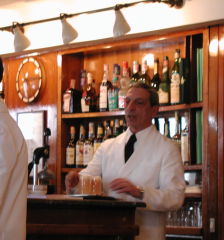
A martini is much more about form than matter. Much
more about ceremony than content. It is very important that it look
correct, that it have the right surroundings and atmosphere. This means
accompanying linens, proper stemware, silver bowls of nuts, etc. But,
of course, a martini is a no nonsense dirk, getting right to the point,
as it were. So spending a little time to do it right, is worth it.
 Which
Gin? This is a matter of
taste, actually. Unlike vodkas which are very much the same
one-to-the-other, gins are very particular. They are flavored with
various spices and each has its own formula. Juniper plays a strong role
in many gins, so one's fondness for the scent of this particular berry
will cause you to select this or that gin. Our favorite is Bombay,
which comes in a regular and the more expensive Sapphire varieties. We
actually prefer the regular. Our friends, Mike and Leslie, are
true martini aficionados (they buy their favorite olives by the case) and
they prefer Beefeaters. One of the most famous Martinis in
the world is made at Harry's Bar in Venice and they use Gordons! - one of the least expensive gins around. (At $10 each, one can only
smile at Cipriani's margins!) Tanqueray is another
excellent brand. Vodka can be used, but of course, it
becomes a vodka martini, which is not really a Martini at all.
Which
Gin? This is a matter of
taste, actually. Unlike vodkas which are very much the same
one-to-the-other, gins are very particular. They are flavored with
various spices and each has its own formula. Juniper plays a strong role
in many gins, so one's fondness for the scent of this particular berry
will cause you to select this or that gin. Our favorite is Bombay,
which comes in a regular and the more expensive Sapphire varieties. We
actually prefer the regular. Our friends, Mike and Leslie, are
true martini aficionados (they buy their favorite olives by the case) and
they prefer Beefeaters. One of the most famous Martinis in
the world is made at Harry's Bar in Venice and they use Gordons! - one of the least expensive gins around. (At $10 each, one can only
smile at Cipriani's margins!) Tanqueray is another
excellent brand. Vodka can be used, but of course, it
becomes a vodka martini, which is not really a Martini at all.
|
Which Vermouth?
Doesn't matter, really. Martini & Rossi
and Cinzano both have stunning labels (remember it
is more fashion then content), and you only
need the smallest bottle available. |
 |
 The
Garnish. This actually is a very
controversial subject. Martini lovers will quickly change brands of gin,
but are jingoistic about their garnish. There are several acceptable
alternatives: a green olive stuffed or not, pitted or not; a lemon peal,
or a cocktail onion. The latter, of course, changes the name of the
drink to a Gibson, which entirely defeats the lore of
having a Martini. To our taste we prefer big green olives - generally
with a pit - only because they are firmer and tastier than the stuffed
variety and avoid the slightly sweet pimento stuffing. There is also the
Picholine, a
very small pale green pitted olive that is marvelous with martinis. This
is what is used at Harry's, served on the side in a silver bowl.
Searching out the correct olive is worth the effort. The important thing
is to get something with pure olive taste. No garlic or other spices.
The
Garnish. This actually is a very
controversial subject. Martini lovers will quickly change brands of gin,
but are jingoistic about their garnish. There are several acceptable
alternatives: a green olive stuffed or not, pitted or not; a lemon peal,
or a cocktail onion. The latter, of course, changes the name of the
drink to a Gibson, which entirely defeats the lore of
having a Martini. To our taste we prefer big green olives - generally
with a pit - only because they are firmer and tastier than the stuffed
variety and avoid the slightly sweet pimento stuffing. There is also the
Picholine, a
very small pale green pitted olive that is marvelous with martinis. This
is what is used at Harry's, served on the side in a silver bowl.
Searching out the correct olive is worth the effort. The important thing
is to get something with pure olive taste. No garlic or other spices.
|
 The
Glass. There is only one acceptable
glass, and it is a stemmed martini glass. The larger the better. One can
always use an old fashion glass and make martinis over-the-rocks, but it
has none of the ritual and all the ice melts
and waters-down
the martini. Harry's Bar in Venice, in another departure, makes their
martinis in small square glasses - like oversized shot glasses. They
make them ahead of time and keep them in a freezer behind the bar.
We have some of these glasses, and they can be quite festive, especially
since they can be pre-made, stored ice-cold in the freezer and then
presented with no fuss, all assembled on a silver platter the moment your
guests arrive. This will instantly get your party
going. The garnish in this case is served in a bowl on the side. The
Glass. There is only one acceptable
glass, and it is a stemmed martini glass. The larger the better. One can
always use an old fashion glass and make martinis over-the-rocks, but it
has none of the ritual and all the ice melts
and waters-down
the martini. Harry's Bar in Venice, in another departure, makes their
martinis in small square glasses - like oversized shot glasses. They
make them ahead of time and keep them in a freezer behind the bar.
We have some of these glasses, and they can be quite festive, especially
since they can be pre-made, stored ice-cold in the freezer and then
presented with no fuss, all assembled on a silver platter the moment your
guests arrive. This will instantly get your party
going. The garnish in this case is served in a bowl on the side. |

Claudio,
the bartender at Harry's serving a couple of Bellinis.
|

Assembly:
|
 Equipment
Equipment
You will need a pitcher
and a long stirrer, or a cocktail shaker, and a cocktail strainer.
If you are using a pitcher, choose a clear glass one so that the
mixing may be observed. You should also have a nice linen
bar towel to keep things neat.
|
The most
important secret to a really good martini
is to insure that it is ICE
COLD.
The best way to achieve this is to put the gin in the freezer at least
the day before, or just leave there all the time.
It won't freeze, but it does thicken quite a bit. In a
situation where you do not have a freezer, put the bottle of gin
on ice for
several hours before serving. Note, however, that it is always best to
keep your vermouth at room temperature. Another good thing to do is to put the glasses in the
freezer. They will instantly frost-over when you take
them out, looking really cool. If this is not possible, then while you are making the martinis
you can put ice in the glasses.
Put a good quantity of ice in the pitcher or shaker.
Don't use crushed ice. It melts too
quickly and will dilute your gin. Next, add the gin. Use enough to fill
each glass by just over 3/4. Add the vermouth.
If you have a full pitcher of gin for a ½ dozen martinis
or so, you could put as much as a vermouth bottle capful. Another good
technique is to put the vermouth in first with the ice. Just a small
pour. Allow it to get real cold and swirl it a bit, then pour out all
but a scant amount.
Anyway, most real martini lovers don't much like the
taste of vermouth in their gin, so you want to minimize its
contribution.
Remember that the gin is already cold, so you don't
need to leave it on the ice too long (and have it contaminate the gin
with too much melted water!). Give it a good shake or swirl with a long
stirrer and pour out the martinis into each glass using a strainer to
leave the ice behind. If you chilled your glasses with ice, make sure
you dump it first along with any melted water.
 Use
lots of flair stirring or shaking and pouring; it is the ceremony
you are creating! Make your martinis memorable even if it is just
Friday evening at home. You can find lots of discussion on
stirring vs. shaking and length of mixing time, with assertions that
shaking “bruises” the gin. Cocky-pock. There might be
some truth that shaking might cloud the martini a bit, and a pristine,
clear drink is certainly one of the goals. Just mix or shake
quickly.
Use
lots of flair stirring or shaking and pouring; it is the ceremony
you are creating! Make your martinis memorable even if it is just
Friday evening at home. You can find lots of discussion on
stirring vs. shaking and length of mixing time, with assertions that
shaking “bruises” the gin. Cocky-pock. There might be
some truth that shaking might cloud the martini a bit, and a pristine,
clear drink is certainly one of the goals. Just mix or shake
quickly.
|
 These
are the olive picks we use. They are silver lemon forks made
by the amazing Venetian silversmith Sfriso. These
are the olive picks we use. They are silver lemon forks made
by the amazing Venetian silversmith Sfriso. |
Add the olive (or if they are
small, several). I think it is always best to spear the olives with a
cocktail pick of some sort, otherwise you will find your guests unseemly
digging their fingers into their martini in order to retrieve the
delectable olive.
Serve!
Always accompany your martinis with tidbits. It helps to remove the
guilt of slurping almost straight gin. It is best to have two
cocktail napkins available for each guest. One for under the glass
and one to wipe finger tips while eating the tidbits.
Drinking Martini Etiquette:
Martinis should always be sipped and never gulped.
Eating the olive right away or waiting until the end when it has become
gin-soaked is one of the few anxieties of martini drinking. Having a
second martini is, of course, another anxiety. Having a third is never
an anxious decision, the second having completely removed any
inhibitions or sense of reason.
Post Scripts
and Amendments:
The
Classic Martini: What I describe here is our preference for an extra
dry martini. The degree of dryness describes the preference for less
vermouth. The classic martini is actually made with 2 parts gin to 1
part vermouth. While not to our taste, it is still a true martini and
just as festive as a very dry one. Of course, any mixture of vermouth
and gin between the classic and the extra dry will do. Just remember if
you use that much vermouth, you will need to leave it on the ice while
mixing a bit longer to insure the drink is very cold.
Gordon's
Gin: We mentioned above that Harry's in Venice uses Gordon's,
and we dismissed this as being a less-than-ideal product for a martini.
As it turns out, we have come to learn that the export Gordon's we get
here in the States is not the same as the very good product available in
Europe.
Further
on the Glass: After the original posting of this article, a
very good friend of ours, Richard Mountain, wrote and said that
he really disagreed with my insistence on a traditional martini
glass, declaring that "a perfect martini in a jelly jar is
still a perfect martini." Well, Richard is the best
customer representative in the gift department at Neiman Marcus
here in San Francisco and he can help you do better than jelly jars
if you need proper glasses.
 On
the Importance of a Cold Martini, Julia Knew Best: We all
morn the passing of one of the icons of culinary America, Julia Child,
who loved her martini. From a quote by food writer GraceAnn
Walden:
On
the Importance of a Cold Martini, Julia Knew Best: We all
morn the passing of one of the icons of culinary America, Julia Child,
who loved her martini. From a quote by food writer GraceAnn
Walden:
"A couple of years ago,
I called her at home for an article I was writing and asked her what
food and drink she would take to a desert island.
"I will need a solar-operated refrigerator so that I can have a
perfectly chilled martini."
I hope Saint Peter greets her with a chilled one,
straight up. "
May we all toast our next martini
to Julia!
E n j o y !
